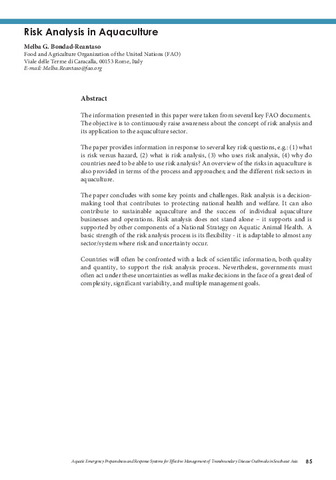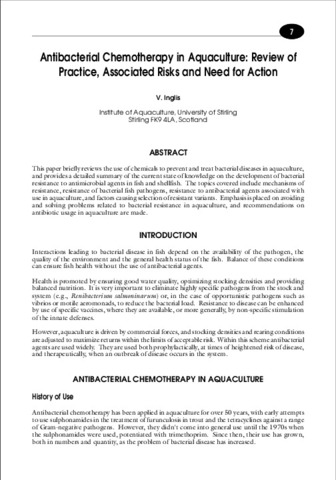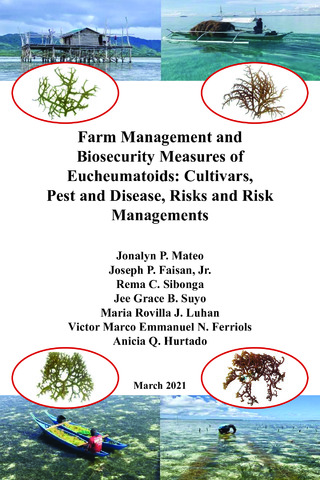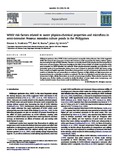Risk analysis in aquaculture
Share
Abstract
The information presented in this paper were taken from several key FAO documents. The objective is to continuously raise awareness about the concept of risk analysis and its application to the aquaculture sector.The paper provides information in response to several key risk questions, e.g.: (1) what is risk versus hazard, (2) what is risk analysis, (3) who uses risk analysis, (4) why do countries need to be able to use risk analysis? An overview of the risks in aquaculture is also provided in terms of the process and approaches; and the different risk sectors in aquaculture.The paper concludes with some key points and challenges. Risk analysis is a decisionmaking tool that contributes to protecting national health and welfare. It can also contribute to sustainable aquaculture and the success of individual aquaculture businesses and operations. Risk analysis does not stand alone - it supports and is supported by other components of a National Strategy on Aquatic Animal Health. A basic strength of the risk analysis process is its flexibility - it is adaptable to almost any sector/system where risk and uncertainty occur.Countries will often be confronted with a lack of scientific information, both quality and quantity, to support the risk analysis process. Nevertheless, governments must often act under these uncertainties as well as make decisions in the face of a great deal of complexity, significant variability, and multiple management goals.
Suggested Citation
Bondad-Reantaso, M. G. (2019). Risk analysis in aquaculture. In E. A. Tendencia, L. D. de la Peña, & J. M. V. de la Cruz (Eds.), Aquatic Emergency Preparedness and Response Systems for Effective Management of Transboundary Disease Outbreaks in Southeast Asia: Proceedings of Asean Regional Technical Consultation, 20-22 August 2018, Centara Grand Central Ladprao, Bangkok, Thailand (pp. 85-91). Tigbauan, Iloilo, Philippines: Aquaculture Department, Southeast Asian Fisheries Development Center.
Subject
disease control  ; Disease detection; disease resistance
; Disease detection; disease resistance  ; disease transmission
; disease transmission  ; epidemiology
; epidemiology  ; husbandry diseases
; husbandry diseases  ; aquaculture regulations
; aquaculture regulations  ; quarantine regulations
; quarantine regulations  ; fish culture
; fish culture  ; fish diseases
; fish diseases  ; aquaculture
; aquaculture  ; risk management
; risk management  ; documents
; documents  ; analysis
; analysis  ; Risks; aquatic animals
; Risks; aquatic animals  ; sustainable aquaculture
; sustainable aquaculture  ; countries
; countries 
 ; Disease detection; disease resistance
; Disease detection; disease resistance  ; disease transmission
; disease transmission  ; epidemiology
; epidemiology  ; husbandry diseases
; husbandry diseases  ; aquaculture regulations
; aquaculture regulations  ; quarantine regulations
; quarantine regulations  ; fish culture
; fish culture  ; fish diseases
; fish diseases  ; aquaculture
; aquaculture  ; risk management
; risk management  ; documents
; documents  ; analysis
; analysis  ; Risks; aquatic animals
; Risks; aquatic animals  ; sustainable aquaculture
; sustainable aquaculture  ; countries
; countries 
Related items
Showing items related by title, author, creator and subject.
-
Antibacterial chemotherapy in aquaculture: review of practice, associated risks and need for action
Inglis, V. (Aquaculture Department, Southeast Asian Fisheries Development Center, 2000)This paper briefly reviews the use of chemicals to prevent and treat bacterial diseases in aquaculture, and provides a detailed summary of the current state of knowledge on the development of bacterial resistance to ... -
Farm management and biosecurity measures of Eucheumatoids: Cultivars, pest and disease, risks and risk managements
Mateo, Jonalyn; Faisan, Jr., Joseph; Sibonga, Rema; Suyo, Jee Grace; Luhan, Maria Rovilla; Ferriols, Victor Marco Emmanuel; Hurtado, Anicia (United Kingdom Research and Innovation-Global Challenge Research Fund (UKRI-GCRF), 2021-03)This brochure was prepared and written after four years of research of the seaweed industry of the Philippines by the GlobalSeaweedSTAR Philippine Team in a layman’s language. This provides the different stakeholders of ... -
WSSV risk factors related to water physico-chemical properties and microflora in semi-intensive Penaeus monodon culture ponds in the Philippines
Tendencia, Eleonor; Bosma, Roel H.; Verreth, Johan A. J. (Elsevier, 2010)Whitespot syndrome virus, WSSV, is the most important among the shrimp diseases. One of the suggested WSSV risk factors is the occurrence of stress since stressors could compromise the shrimp defence system thus increasing ...




